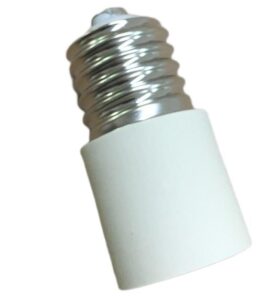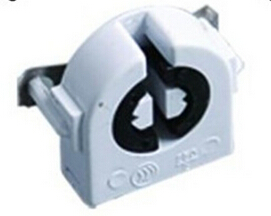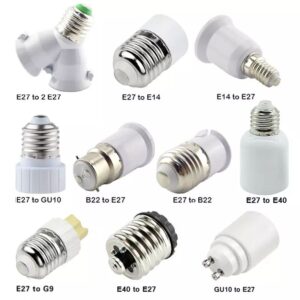Having trouble figuring out which fluorescent lamp socket you need for your lighting project? If you pick the wrong one, you’ll have a light that doesn’t work well, and you’ll have to replace it all the time.
Fluorescent lamp sockets are categorized by the size of the tube, which is primarily T5, T8, and T12. Each type of socket is made to fit the specific size of the tube to make the right electrical connections to provide good lighting.
To figure out what kind of fluorescent socket you need, it helps to understand a little bit about fluorescent lighting.

What is T5, T8, and T12 lighting?
Fluorescent lighting primarily uses three types of tubes: T5, T8, and T12. These designations refer to the diameter of the tube, measured in eighths of an inch. A T5 lamp has a diameter of 5/8 inch, T8 is 1 inch, and T12 is 1.5 inches in diameter. The number associated with the T indicates the diameter of the tube in eighths of an inch.
T5 lamps are more modern and energy-efficient, often used in commercial settings where high-efficiency lighting is required. T8 lamps are commonly used in office spaces and residential areas, offering a balance between efficiency and brightness. T12 lamps, being the oldest and least efficient, are gradually being phased out but are still found in older installations. Each type of lighting has its specific uses depending on the desired energy efficiency and brightness.
What are the different types of fluorescent light fittings?
Fluorescent light fittings come in a variety of designs depending on the application. The most common fittings are for T5, T8, and T12 tubes, which are mounted using pin-based sockets. These sockets are typically categorized as either G5 or G13. The G5 socket is designed for T5 tubes and features pins that are spaced 5 millimeters apart. In contrast, the G13 socket, used for both T8 and T12 tubes, has pins spaced 13 millimeters apart.
Other types of fittings include weatherproof and industrial-grade sockets designed for environments that require durable or sealed lighting solutions. These fittings are often found in places like garages, factories, or outdoor areas where moisture or dust might affect the light’s functionality. Fluorescent sockets are versatile, accommodating a range of lighting setups depending on the area and specific lighting needs.

What are the 3 types of regular fluorescent lamps?
The three main types of fluorescent lamps are linear, compact, and circular. Linear fluorescent lamps, such as T5, T8, and T12, are the most common and come in straight tubes. Compact fluorescent lamps (CFLs) are smaller versions of traditional fluorescent lamps and are often used in residential lighting due to their energy efficiency and longevity. They typically have a spiral or U-shaped design.
Circular fluorescent lamps are similar in technology to linear fluorescent lamps but are designed in a round shape to fit specific fixtures. These are often used in decorative lighting or for illuminating larger spaces uniformly. Each type of fluorescent lamp is suited for different environments, but they all rely on the same basic principles of using phosphor-coated tubes to convert electrical energy into visible light.
What is the difference between T8 and T12 fluorescent light fixtures?
The primary difference between T8 and T12 fluorescent light fixtures lies in the diameter of the tubes they support and their energy efficiency. T8 fixtures accommodate 1-inch diameter tubes, while T12 fixtures hold the thicker, 1.5-inch tubes.
T8 lamps are generally more energy-efficient, emitting a higher lumens-per-watt ratio compared to T12 lamps. Additionally, T8 fixtures typically use electronic ballasts, which eliminate the flickering and buzzing that are often associated with older T12 fixtures that use magnetic ballasts. As a result, T8 fixtures have become the standard in most modern installations, while T12 fixtures are being phased out due to their higher energy consumption and lower efficiency.
How do I know if my fluorescent bulbs are T8 or T12?
To identify whether your fluorescent bulbs are T8 or T12, you can check the diameter of the tube. A T8 bulb is 1 inch in diameter, while a T12 bulb is 1.5 inches in diameter. If the size isn’t immediately apparent, you can also look for the label printed on the tube, which should indicate whether it is a T8 or T12.
Another method is to examine the fixture’s ballast. If it’s an electronic ballast, it is likely designed for T8 bulbs. In contrast, older magnetic ballasts typically support T12 tubes. Checking these details ensures that you are using the correct bulb for optimal lighting performance and energy efficiency.

What is the difference between T5 and T8 fluorescent tubes?
T5 and T8 fluorescent tubes differ in size and energy efficiency. A T5 tube is smaller, with a diameter of 5/8 inch, while a T8 tube has a diameter of 1 inch. T5 tubes are typically more energy-efficient and are used in high-output applications such as offices, schools, and commercial buildings.
In terms of performance, T5 tubes produce more light in a smaller form factor, making them suitable for spaces with limited room for larger fixtures. However, T8 tubes are more commonly found in standard office and residential settings because they offer a good balance between light output and efficiency. Both types have their unique advantages, and the choice between them depends on the specific lighting requirements of the space.
Can I replace a T5 bulb with a T8?
No, you cannot replace a T5 bulb with a T8 bulb directly because the sockets and ballasts used for these two types are different. T5 bulbs use G5 sockets with pins spaced 5 millimeters apart, while T8 bulbs use G13 sockets with pins spaced 13 millimeters apart. Additionally, the ballasts designed for T5 tubes operate at a different current and voltage than those for T8 tubes.
If you want to switch from T5 to T8 or vice versa, you would need to replace the entire fixture or at least the ballast and socket to accommodate the new tube size. It’s crucial to ensure compatibility between the lamp, ballast, and socket to avoid damaging the fixture or reducing the bulb’s lifespan.

How do you replace a fluorescent light fixture with an LED fixture?
Replacing a fluorescent light fixture with an LED fixture is relatively straightforward. First, turn off the power to the fixture and remove the fluorescent tubes. Next, disconnect the ballast, as LED tubes do not require a ballast to function. Once the ballast is removed, connect the LED driver or direct-wire the fixture to the electrical supply following the manufacturer’s instructions.
After wiring, install the LED tubes and secure them in place. Finally, restore power and test the fixture. This upgrade not only reduces energy consumption but also eliminates the need for future ballast replacements, making LED a more efficient long-term solution.
Fluorescent tube sockets come in different types to fit different sizes of tubes and fixtures.













